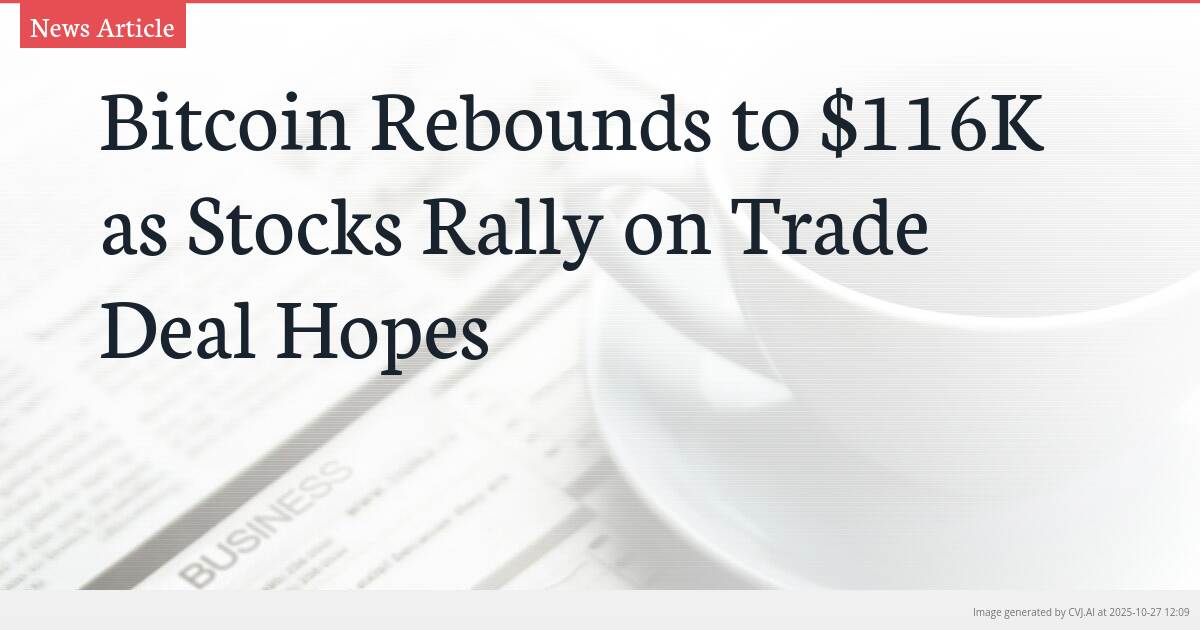This summary text is fully AI-generated and may therefore contain errors or be incomplete.
Introduction
Bitcoin staged a strong recovery to $116,000 as the cryptocurrency attempts to regain momentum after recent declines, while traditional stocks surged on growing optimism about a potential US-China trade agreement. Despite the rebound, traders remain cautious about Bitcoin’s ability to sustain its bull run, creating a complex market dynamic as the Federal Reserve’s FOMC meeting approaches.
Key Points
- Bitcoin price rebounded to $116,000 but failed to convince traders of sustained bull market momentum
- Traditional stocks rallied on reduced likelihood of new US-China tariffs, creating divergent market sentiment
- The recovery occurs during FOMC week with markets watching Federal Reserve policy decisions closely
Bitcoin's Volatile Recovery
Bitcoin opened the final week of October with a significant rebound, climbing to $116,000 and closing the weekly session at $114,500 as bulls attempted to reverse recent declines from all-time highs. This recovery represents a welcome development for cryptocurrency investors who had watched BTC price action struggle to maintain its upward trajectory. The move higher came after a period of consolidation and testing of lower support levels, with the $116,000 level serving as a critical psychological barrier for market participants.
Despite the price improvement, many traders remain unconvinced about the sustainability of Bitcoin’s bull market momentum. The cryptocurrency’s failure to decisively break through resistance levels and establish new highs has created nervousness among both retail and institutional investors. This cautious sentiment reflects broader concerns about whether the current recovery represents a genuine resumption of the bull trend or merely a temporary bounce before further declines.
Traditional Markets Find Relief in Trade Developments
While Bitcoin traders navigated uncertainty, traditional stock markets experienced a significant relief rally driven by reduced expectations of new US-China tariffs. The improved sentiment around a potential trade deal between the United States and China provided a strong tailwind for equity markets, creating a divergence in market performance between cryptocurrencies and traditional assets. This development highlights how geopolitical and trade developments continue to influence global financial markets.
The stock market’s positive reaction to the reduced tariff odds underscores the ongoing sensitivity of traditional markets to US-China trade relations. Investors in conventional assets breathed a sigh of relief as the prospect of escalating trade tensions diminished, allowing risk appetite to return to equity markets. This dynamic creates an interesting contrast with the cryptocurrency space, where Bitcoin’s movements appear more influenced by internal market factors and technical considerations than by traditional geopolitical developments.
FOMC Week Adds Complexity to Market Sentiment
The recovery in both Bitcoin and traditional stocks occurs during a critical period for monetary policy, with the Federal Reserve’s FOMC meeting taking center stage this week. Market participants across both cryptocurrency and traditional finance are closely watching the Federal Reserve’s decisions and guidance, as monetary policy developments can significantly impact risk assets of all types. The timing of Bitcoin’s rebound alongside stock market gains creates a complex backdrop for the FOMC’s deliberations.
Traders in both markets face the challenge of interpreting how Federal Reserve policy might affect their respective asset classes. For Bitcoin, the relationship with traditional monetary policy has become increasingly important as institutional adoption grows. The cryptocurrency’s performance during FOMC week will be closely scrutinized for clues about its evolving role in the broader financial ecosystem and its sensitivity to central bank actions.
The mixed sentiment across financial markets reflects the competing influences of technical factors in cryptocurrency trading, geopolitical developments affecting traditional stocks, and monetary policy uncertainty from the Federal Reserve. As investors navigate this complex landscape, the divergence between Bitcoin’s cautious recovery and stocks’ more confident rally highlights the different drivers and risk profiles of these asset classes in the current market environment.
📎 Read the original article on cointelegraph.com

